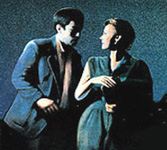A new kind of narration, a new use of time and space.
Chantal Akerman's 1982 film Toute une nuit is a cinematic ballet, a nocturnal symphony that captures the movements of attraction and repulsion between lovers over the course of a summer night in Brussels. Beginning at dusk as the calm of the evening quiets the city, and concluding the following morning with the deafening sounds of morning traffic, the film follows anonymous individuals as they meet and separate. The darkness of the urban evening provides a backdrop for the choreography of love, the melodramatic gestures of the actors materializing like luminous fireflies from the shadows. These gestures take center stage in this film, while the nameless characters and discontinuous mini-narratives function merely as props through which movement is realized. Akerman does not use narrative in the film in order to achieve continuity; rather, she creates continuity through constant affective change that endures throughout the film. In other words, the discontinuity of Akerman's collection of fragmented narratives, often abruptly cut and seemingly independent are fused in affect; the melody of a pop song carried across the city by the wind, the clacking of footsteps on city pavement, rustling leaves, slamming doors, and most importantly the poses and gestures of the actors' bodies merge in order to suggest affective change.
[…]
Darlene Pursley
http://muse.jhu.edu/cgi-bin/access.cgi? ... rsley.html




